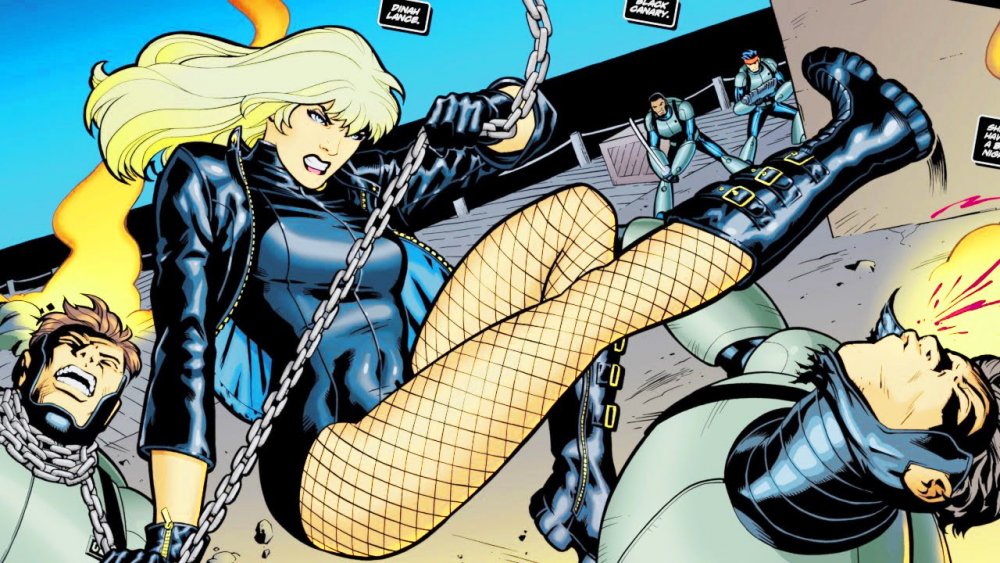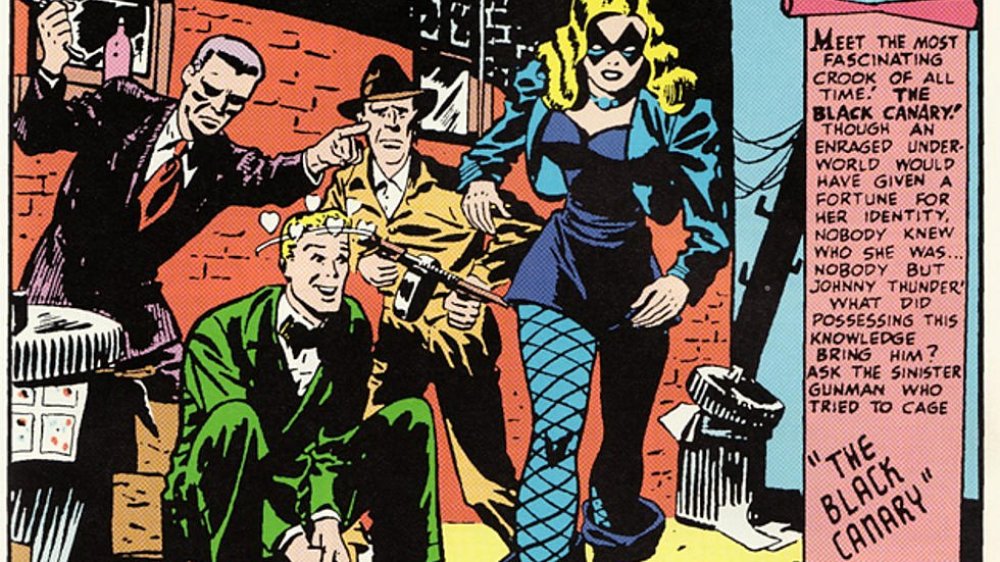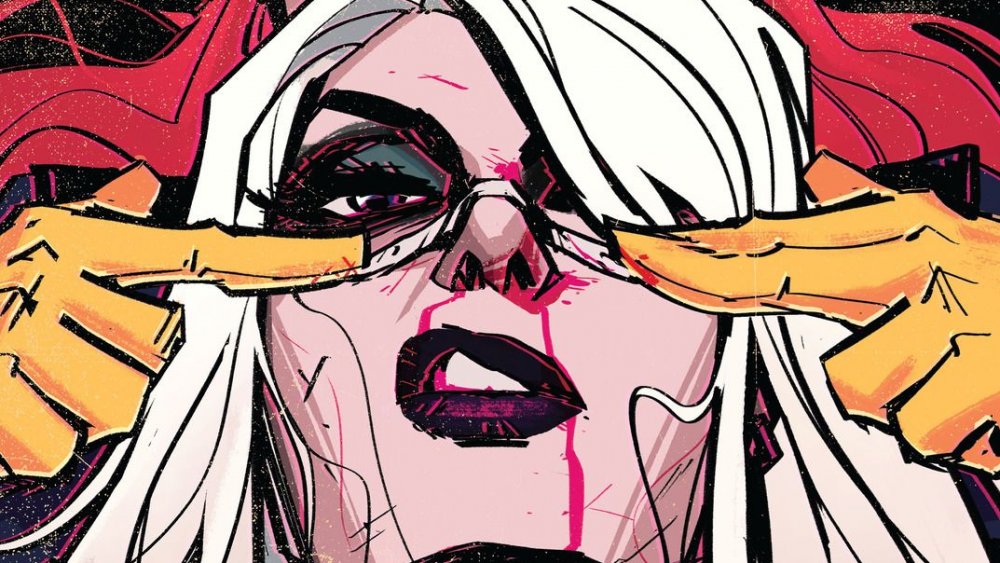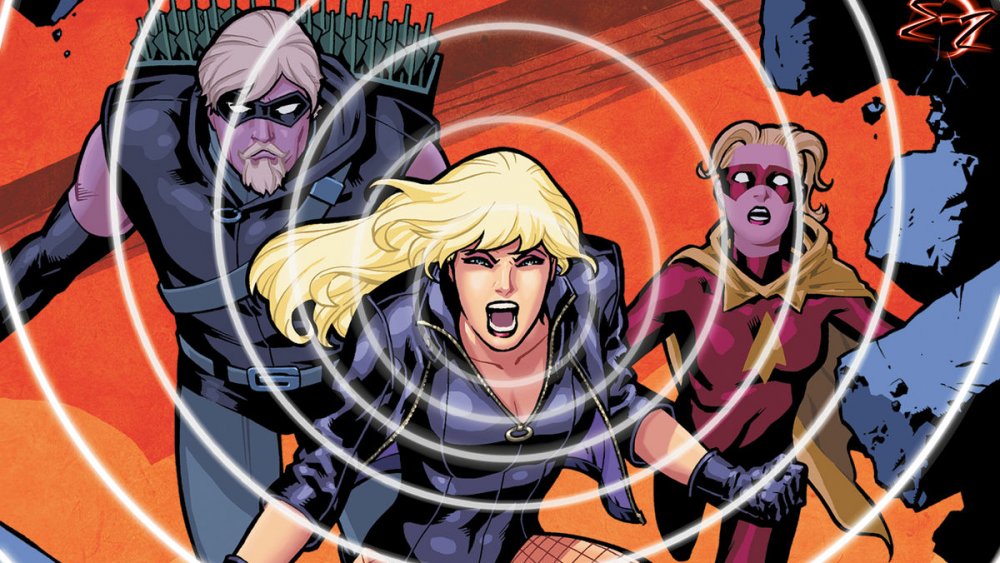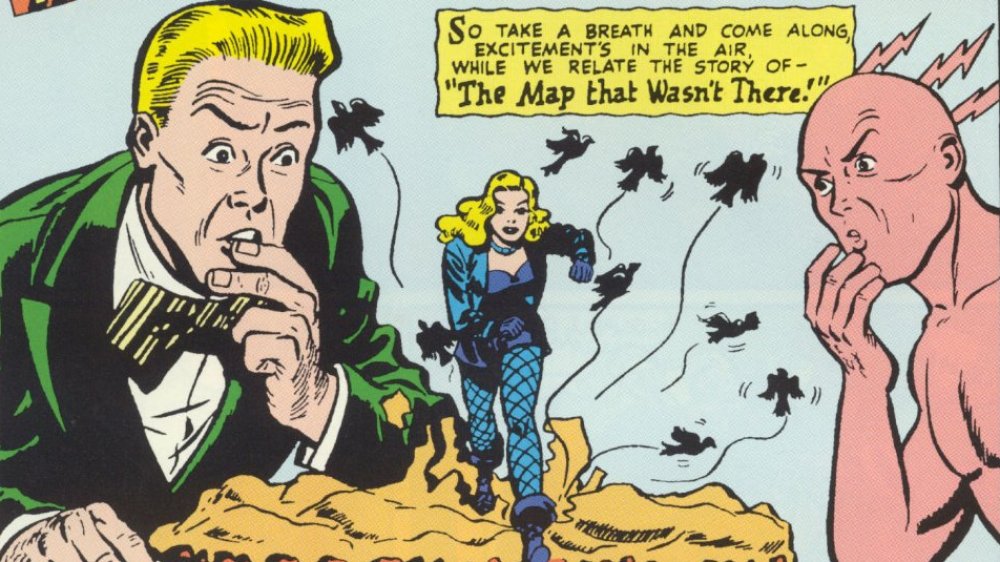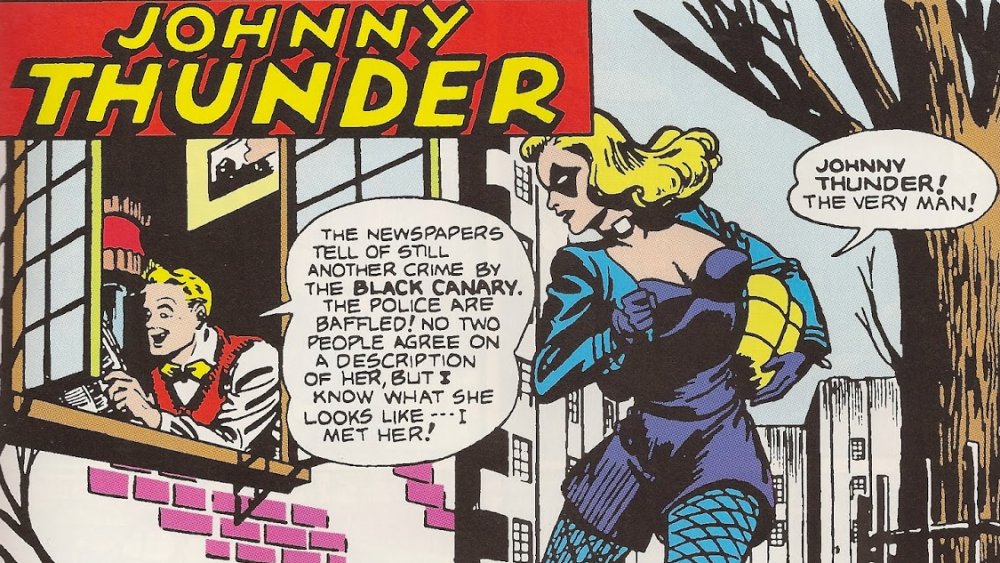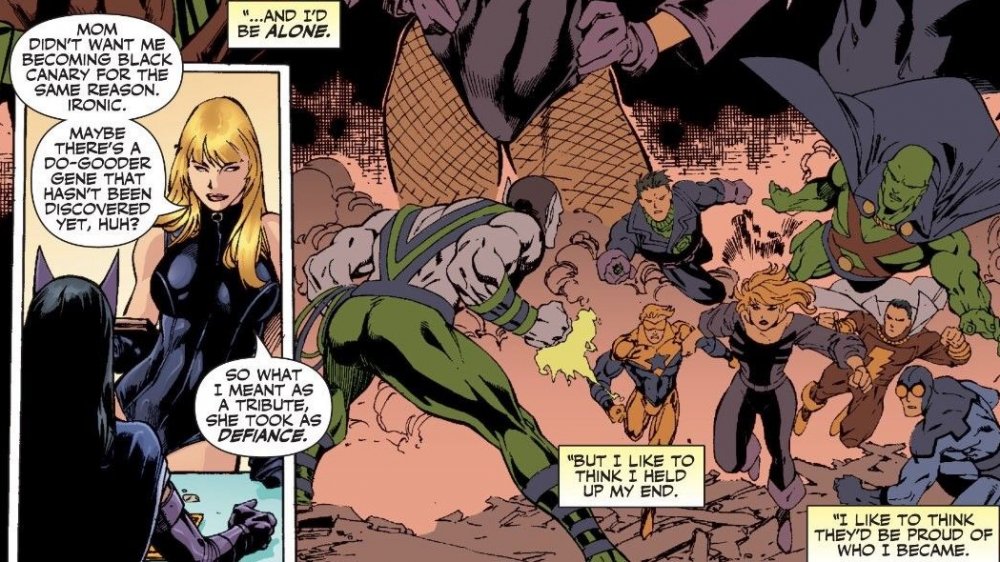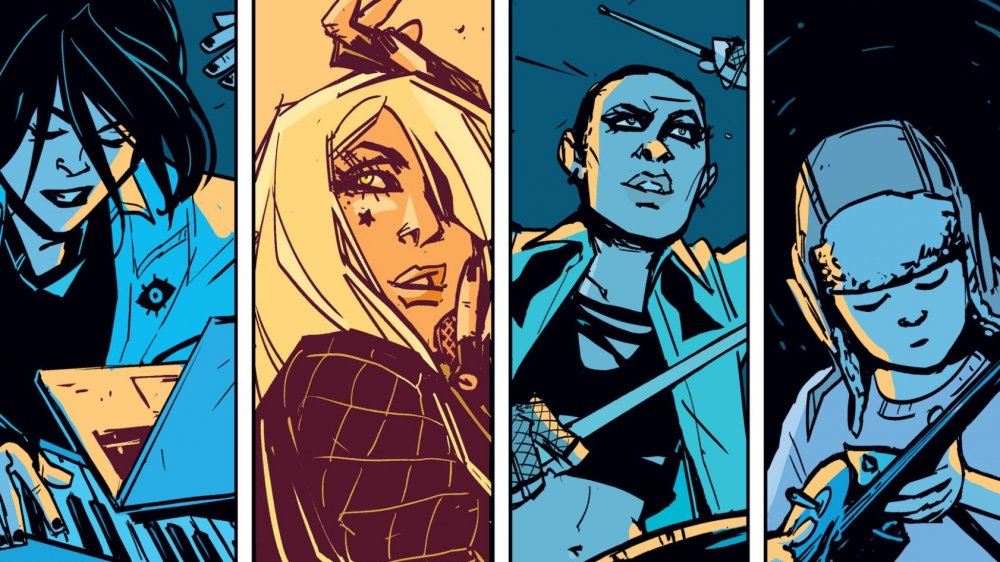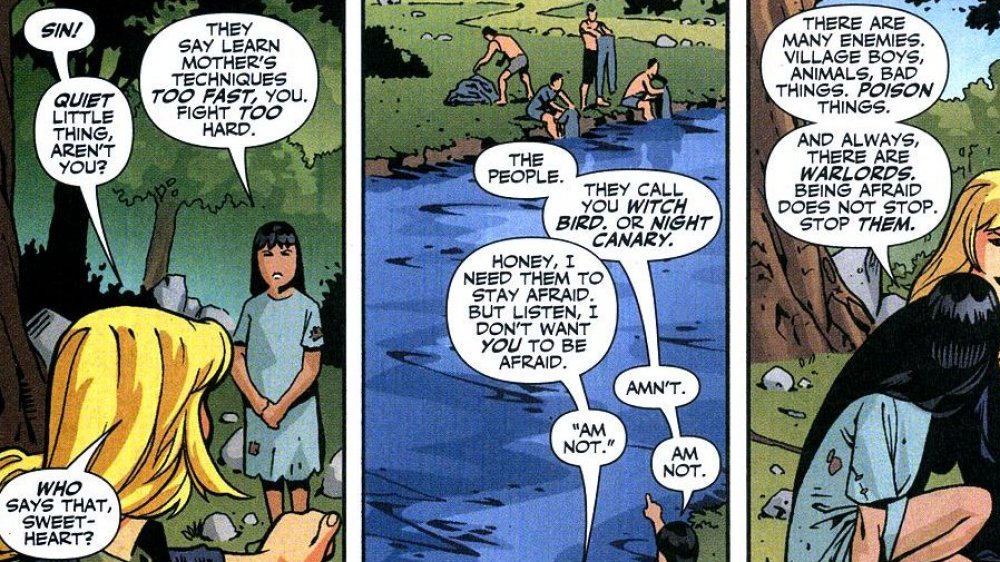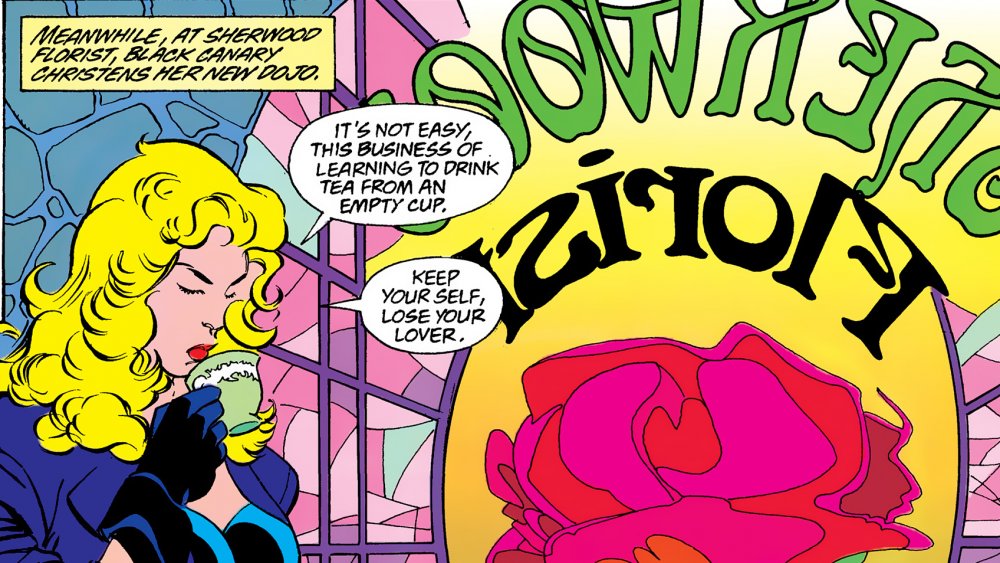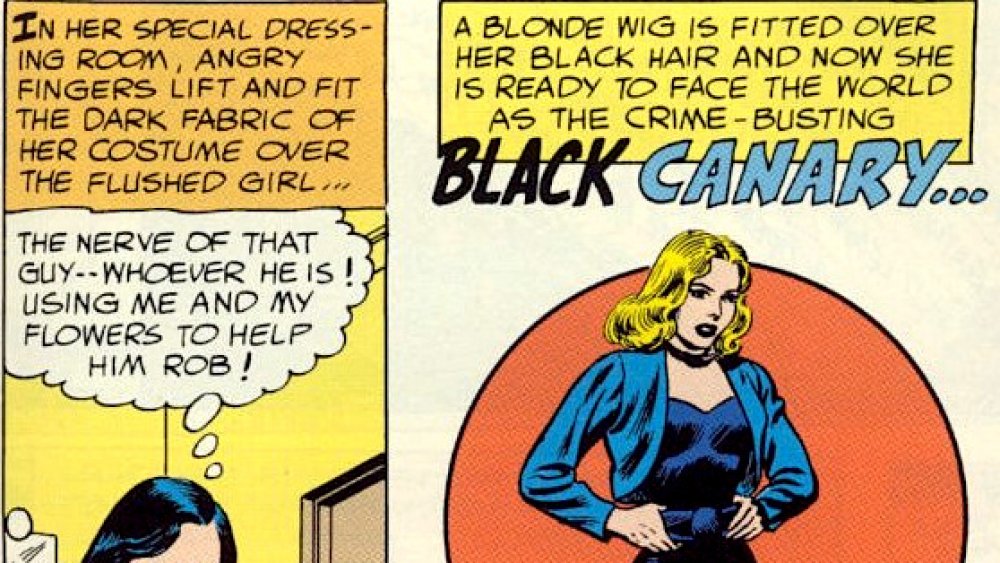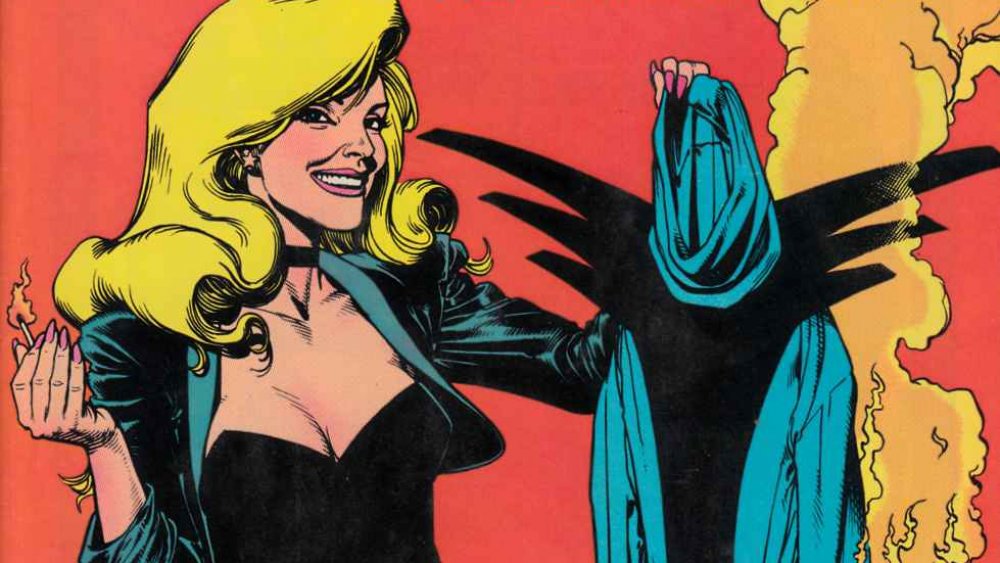The Untold Truth Of Black Canary
Beloved across decade and medium, Black Canary is a superheroic stalwart. Crackling action scenes featuring unique powersets? As a peerless martial artist with a steel-shattering Canary Cry, she's got you. Team-based stories involving characters from every corner of the far-flung DC universe? She's as comfortable doing covert ops for the Birds of Prey as she is heading into space as part of the Justice League. Soap opera shenanigans that keep fans engaged for years? Don't even get her started on whether she and Green Arrow are currently on or off. From her animated escapades on Justice League Unlimited to her decades of adventures in print, Black Canary's dauntless do-gooding never disappoints.
But for all the time she's spent literally kicking and screaming her way through the DC Universe, she remains a character of unplumbed depths. Sure, you might know that she's good with her fists, but do you know about the anachronistic day job the character's been associated with for decades? How about her time in rural Vietnam? What era of comics do you think she debuted in? The answers won't just surprise you — they'll reframe everything you thought you knew about DC's fiercest fighter in fishnets. Join us as we explore Black Canary's weird hobbies, little-known side-hustles, and controversial costume changes.
Black Canary's Golden Age beginnings
One might not suspect Black Canary of being one of DC's earliest superheroines. She's not as widely-known a name as Superman, Wonder Woman, or other DC debuts of that era, for one thing. Moreover, her costume seems far more in line with the latter half of the 20th century, to the comics layman. Fishnets and leather would have been far too edgy for a squeaky-clean superheroine of the 1940s, right? If asked to put a date to her comics creation, one might pin her to the 1980s, a la her Birds of Prey teammate Huntress: old enough to be in the cartoons, young enough to have been kept from most of the movies.
Yet for all the sense those conclusions make, they are entirely wrong. Black Canary is, in fact, one of the DC's earliest superheroines, having debuted in 1947's Flash Comics #86. That's right: Alongside Wonder Woman, Batman, and Superman, Black Canary is a Golden Age creation who predates heavy-hitters like Supergirl, Batgirl, and Martian Manhunter. Furthermore, she's remained relatively intact since her debut — even that outre outfit. Sure, she initially sports a roomy pair of shorts and a domino mask that ended up forgotten, but with her dark jacket, fishnet tights, blonde sweep of hair, and striking black boots, there's no confusing the dangerous dame on the page for anyone but Black Canary. She isn't just deeply embedded in the DC universe — she is utterly foundational.
Black Canary is one of DC's fiercest fighters
The DC universe contains no end of fabulous, physics-defying superpowers. Flight and super-strength are positively commonplace, eye lasers come in a rainbow of colors, and forces as amorphous as luck can be manipulated by those with the appropriate power set. It's easy to imagine that someone without that level of superpowered supremacy wouldn't much rank in this world of titans and monsters — and yet the opposite is true. Non-powered characters are distinguished all the more by the fact that they, un-augmented, non-alien, and containing no cybernetic parts, keep pace with the ultra-powered demi-gods they call teammates.
Black Canary is a sterling example of this, being one of the best fighters in the DC Universe — to the point that her Canary Cry, her singular superpower, ranks below her martial arts prowess. Her training is extensive, putting a wide variety of martial arts under her belt, topped off with the street fighting skills she's been shaping since childhood. Moreover, she's studied under masters ranging from Wildcat, a world-class boxer, to Wonder Woman. Barbara Gordon once remarked within the pages of Birds of Prey that she is fairly certain Black Canary is "good enough to take down Batman himself" — high praise indeed from the woman who was once Batgirl, and thus uniquely equipped to judge. Whether she's part of a team or off on her own, one thing is for certain: Black Canary can take care of herself.
Black Canary hasn't always had her Canary Cry
In possessing a specific and singular superpower, Black Canary occupies a slim slice of superhero-dom. Her Canary Cry isn't part of an overarching, bird-themed powerset, nor is it but one manifestation of a larger control over soundwaves. It is her one extraordinary gift, usable in one extraordinary way: an ultrasonic scream that can deafen opponents, shatter masonry, and generally stun those around her.
Even this superpower, however, hasn't always been part of her kit — and its origins tend to change every decade or so. Initially, the Cry was a curse from the fiendish Wizard, a Golden Age supervillain who menaced the first Black Canary, Dinah Drake. Years later, the ability was attributed to Black Canary's possession of a superpowered metagene. But before either of these origins, from her debut in 1947 to the 1969 issue that introduced the Canary Cry, Dinah Drake fought crime with nothing but her fists. While those years of merely human power are certainly part of what makes Black Canary such a celebrated fighter, the Cry has become as much a part of the character as her physical prowess — and just as exciting to watch in action.
From backup feature to leading lady
Though she's struck out on her own more than once, Black Canary is still best known as a team player. This holds true across medium: from Justice League Unlimited to the Arrowverse, she shines brightest when working with others. It's no surprise, then, to learn that she began as a supporting player in another character's story — albeit one she entirely overshadowed in only a couple of issues.
Black Canary made her debut in Flash Comics #86, but she wasn't actually featured in the issue's main story, a Flash caper entitled "Stone-Age Menace." Instead, she began her comics career as a side character in Johnny Thunder, a backup feature Canary co-creator Carmine Infantino described as starring a "loser." There she strode across the splash page, a caption box describing her as "the most fascinating crook of all time." The audience embraced her immediately, and, as Infantino detailed, that meant it was "'bye bye, Johnny Thunder.' Nobody missed him."
Black Canary's villainous origins
She might be one of DC's gutsiest good guys, but Black Canary actually began her costumed career on the wrong side of the law. Flash Comics #86 presents her as a mendacious moll who slinks out of alleys, corners unsuspecting everymen, and gets them to do her dirty work. Johnny Thunder was suckered within three panels, eager to help the lithe blonde claiming to need his help breaking into a safe (for totally above-board, non-law-breaking reasons, she claims — until, of course, they are revealed as criminal). The day is saved, though Black Canary gets away in the scrum.
The story's final panel sees Johnny Thunder wistfully wondering if he'll ever see her again, only to be reproved by Yz, the genie-like entity that grants him powers and merits him a comic book. Yz, considerably savvier than his master and an early fourth-wall-breaker, tells Johnny to let the dame go, as he's "tired of heroes in comic books falling in love with beautiful villainnesses! You're not much a hero, m'lad, but you don't fall in love... not in this story!" He wasn't wrong, as Johnny Thunder didn't end with Black Canary... but only because she'd go on to eclipse him so fully, necessitating a quick retcon into having been pretending towards villainy for do-gooder purposes all along.
Two women, one Black Canary
DC comics has long been known for its love of legacy characters. Beloved heroes age, leaving behind the mantle of Robin, the Flash, or Green Lantern, only for younger, starry-eyed newcomers to pick it up once more. The title becomes totemic, more symbol than person, and altogether richer to read. Black Canary is part of this history as well — but not in the way one might expect.
Two women have worn Black Canary's trademark fishnets over the years: Dinah Drake and Dinah Lance. Drake is the original Canary who debuted in Flash Comics #86, joined the Justice Society of America, and ultimately married a Gotham detective on whom she'd long nursed a crush. Lance is, in many continuities, their daughter — but a 1983 storyline transplanted Drake's mind into Lance's comatose body, creating a Frankenstein Canary who was, in essence, both mother and daughter in one heroine. 1986's Crisis on Infinite Earths swept this particular innovation away, ushering in a new vision of Drake as a retired vigilante and Lance as her daughter, eager to take up the mantle. In any universe, the women are united by a passion for justice — and only occasionally brain-swapped into a singular body.
From the Hall of Justice to the stage
Black Canary has been a crook, a pugilist, a wife, and a teammate, but recent DC stories have added yet another title onto her ever-lengthening resume: musician. The 2014 reimagining of Batgirl, helmed by writers Brenden Fletcher and Cameron Stewart and illustrated by Babs Tarr, took Dinah along for its ride through Burnside, Gotham's hippest neighborhood. There, Black Canary stepped into the spotlight as the lead singer of Ashes on Sunday, an up-and-coming indie band distinguished by its raw sound, mysterious frontwoman, and absolutely killer vocals.
This idea was so compelling, it spun off into the 2015 Black Canary series, which saw Dinah headlining a band called Black Canary. It's not quite as egotistical as it sounds: Dinah had rechristened herself D.D. in an effort to outrun her past. The hard-traveling heroine and her bandmates were nevertheless embroiled in superheroic shenanigans from the first issue that built to a stage-shattering climax. Though the series ended with its twelfth issue, it was a wonderfully raucous detour few fans will ever forget.
Black Canary: fighter, singer — mother?
Superheroics have a way of throwing unlikely people together. Witness Sin, a young girl Black Canary encountered while training in a remote Vietnamese village: orphaned, abused, and groomed to become the next Lady Shiva, assassin par excellence. Though Black Canary had elected to train in this brutal encampment, she could not help but be drawn to the lonely girl, whose choices were so vastly fewer — and so, after deciding she was ready to return home, Black Canary spirited Sin along with her.
Though her love for the girl was real, so was the struggle to combine the life of a vigilante with that of a mother. In an effort to mesh the two halves into a whole, Black Canary stepped away from her Birds of Prey duties for a while, to better look after Sin. Unfortunately, everything that comes with being a superhero got in the way of domestic bliss, and Sin had to be sent away to a distant boarding school, far beyond the reaches of malcontents in spandex. Though the pain of separation was acute, Black Canary made frequent trips to visit her ersatz daughter, who was, at last, free to enjoy her childhood.
Fishnets, nunchuks, and bouquets
What comes to mind when one thinks of Black Canary? Black leather, fisticuffs, eardrum-puncturing screams, most likely. But like any comic character who's been around since the Golden Age, Black Canary contains multitudes far beyond whatever fans consider to be codified canon. The best example? Her long-running history in the world of floral arrangement.
That's right: Black Canary is a florist. This isn't a singular storyline, nor a modern addition by some upstart writer with odd ideas. No, Black Canary's side-hustle in bouquets has been around since the beginning, regularly returned to when the character could use a reset. The original Canary, 1947's Dinah Drake, began as a florist, an origin that was maintained in 1990's Secret Origins #50 reboot of the Canary canon. Though that issue saw Drake reimagined as a vigilante working in memory of her father, it kept the flower shop as her day job. This vocation endured in Drake's daughter, evidenced chiefly by the 1987 Green Arrow: The Longbow Hunters series. That story saw Dinah, alongside Green Arrow, move to Seattle and open Sherwood Florist in an effort to keep their costumed feet on the ground. Though they managed to live in relative peace for a time, the cape-and-cowl set came knocking eventually, and Sherwood Florist had to close. Still, it's only a matter of time until Black Canary returns once more to her floral roots.
Black Canary is a blonde bombshell with dark roots
Black Canary's blonde head of hair is seemingly as key to her character as her Canary Cry. Try, for a moment, to imagine her without it. Looks weird, right? It's like trying to picture Wonder Woman as a redhead, or Batman with a mullet. It simply does not work, and as such, it is tempting to believe the fact of her blondeness to be absolute.
And yet it isn't. Black Canary hasn't just had other hair colors — her earliest incarnation, the font from which all Black Canary stories have flowed, was a brunette. Dinah Drake, hair as black as night, disguised herself with a flaxen wig, a tradition her daughter, the second Black Canary, continued. A little digging turns up a dark-haired Dinah all over the character's history, including an intermittent flirtation with portraying the character sans wig, even in costume. It was only in the pages of the 2000s Birds of Prey series that Dinah decided to go blonde full time, her disguise discarded in favor of regular bleaching. A gutsy move for a superheroine without a mask — but then, Black Canary is about as gutsy as anyone can get.
Canary's new costume courts controversy
Clothes make the man, in comics as in life, to the point that a hero's costume matters just about as much as his powers. Sure, Superman doesn't hang up his heat vision alongside his cape, but can you imagine him without that bright, billowing banner of red behind him? So it goes with Black Canary, as identified by her jacket, leotard, fishnets, and boots as by her supersonic scream. Given the fact that her outfit has remained largely intact over the years, one would think it had never been deviated from all that dramatically. Sure, you might think, maybe there's been some hem-altering and jacket-studding, but that's probably all it amounts to, right?
Wrong. Black Canary hasn't just come clad in other costumes — she's caused genuine controversy with them. Her most eye-catching costume change debuted on the cover of 1985's Detective Comics #554: a loose, full-body jumpsuit with a bird motif, white buccaneer boots, a black headband, and a hairstyle straight out of Dynasty. With its more-is-more approach, it's about as 1980s as a design can get — and immediately controversial among fans. So much so, in fact, that 1988's Action Comics #609 featured Black Canary on the cover, back in her classic duds and grinning as she took a match to the much-hated jumpsuit. Though she might always have her fists, wit, and fearless nature, to fans, she's just not Black Canary if she's not in her essential ensemble.
